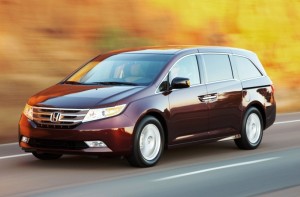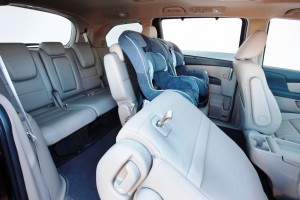
Like all automakers Honda is attempting emotional styling. The real rational story is on the inside.
The success of the minivan was likely the reason for the subsequent irrational success of sport utility vehicles. Minivans screamed “mom-mobiles,” sending the kids raised in them – as well as more fashion conscious suburbanites – into hard riding, gas guzzling trucks to avoid the perceived stigma. Then when “crossovers” appeared, the easier riding, more fuel-efficient van segment took a further hit. Sales dwindled, and mainstream makers such as General Motors and Ford Motor (given their badly outclassed products) abandoned minivans entirely. No surprise then that during the last six years, sales of minivans have plummeted from more than 1.1 million units annually to about 500,000 today.
Minivans are now largely a three, maybe four company contest, depending on your bias. Honda with its Odyssey has led in sales for most of the past decade, averaging 145,000 annually over the last five years, but tracking at 100,000 today in a depressed market. Still, this allows it to retain leadership, but it is down significantly from more than 170,000 Odysseys sold in 2006 and 2007. Chrysler, even though it invented the modern minivan back in the 1980s, lags Honda by roughly 10,000 units a year on its Town&Country and Dodge Caravan models taken separately, although if you add the two together, it leads. Then there are, arguably, the real competitors in many shopper’s minds, the Toyota Sienna, refreshed last year, but still lagging aging Odysseys sales, and the also old Nissan Quest, due to be replaced next year.
Honda is placing a couple of large bets with the 2011 Odyssey, a heavily revised version of its third generation people hauler that appeared in 2005. I do mean large.

No other current minivan interior comes close for packaging efficiency and versatility.
The new Odyssey is wider and longer than its predecessor, in a calculated effort to take minivan utility even further. To be fair, it is also lower and more efficient in a powerful demonstration of incremental engineering changes compounding into a salubrious effect. Moreover unlike Detroit automaker engineering habits, Honda took weight out in the process.
On paper, the 2011 Odyssey’s exterior length of 202.9 inches is 0.8 inches longer, the width of 79.2 inches is 2.1 inches wider and the height of 68.4 inches is 0.4 inches shorter (not including the previous model’s roof rails, which now become a dealer-installed accessory). The 2011 Odyssey’s passenger volume of 172.6 cubic feet (LX) increases by 1.2 cubic feet compared to the 2010 model (LX). Weight-saving measures result in a curb-weight reduction between 50 pounds (Odyssey LX) to 103 pounds (Odyssey Touring) compared with 2010s. In person it’s a bigger change than the digits suggest.
By adding more than two inches in width, the Odyssey with its three rows of seating can hold six adults in comfort or accommodate a family of eight. There are five child seat “latch” positions, including three – yes, three – in the second row.
I hate to use the “best in class” cliché, but in terms of flexibility in seating and cleverness of the interior design on everything from cupholders to consoles to small item storage compartments, Odyssey is a formidable offering that can’t be topped. It is so good, it could effectively block GM and Ford from tackling the segment once again, if they have any thoughts of doing so.
I can’t decide if I like best a new “3-mode” second-row seat design that expands and contracts laterally or the one-motion- deploying, 60/40 split third row seat or the new second row adjustment that allows easy access to the third row – even with two child seats in place in the second row. Try that in brand X.
The third row provides improved legroom, along with better sight lines out of the side windows – a functional improvement resulting from the exterior’s signature “lightning-bolt” belt line. Look in the rearview when driving and you can see through the tailgate, without the limited view and “canyon” effect of the Sienna.
Paradoxically, the larger size doesn’t hurt the fuel economy returned by the 3.5-liter i-VTEC V6 engine, now with 248 horsepower (+4) and 250 lb-ft. of torque (+5 or +10 depending on model). There’s a new six-speed automatic transmission, a Honda first – at last – standard on the Touring model, which achieves class-leading EPA city/highway fuel economy of 19/28 mpg. A day of test driving affirmed those predictions.
However, most models will be equipped with a five-speed, which is standard on the LX, EX and EX-L, which have city/highway fuel economy ratings of 18/27 mpg (+2 or +4 compared to 2010 Odyssey LX, EX). Saving the day here is iVariable Cylinder Management (VCM). To conserve fuel when power requirements are low, the VCM technology lets the engine run using only three or four of its six cylinders when conditions permit. VCM uses both an audio-system-based active noise cancellation (ANC) system – whether or not the system is on- and a chassis-based active control engine mount (ACM) system to cancel noise and vibration that can occur during cylinder deactivation. As with the VCM system already used on other Honda and Acura models, operation is transparent – and I say that looking for its operation during several hours of driving.
This leads to the question who will drive the new Odyssey?
Honda claims that a cultural shift is underway with a younger generation more open to the concept and image of a minivan. Here’s the reasoning from the Americans on the program: Generation Y and Generation X were the first to use minivans as children. To the younger generations now becoming parents, a minivan can represent and support the value of “quantity time” with family and friends, which is more frequently cited as a priority compared to the “quality time” those parents from the Baby Boomer generation used as a justification to pursue dual careers while the kids were chauffeured by (illegal?) nannies. Regardless of the purchase reason and what it may potentially represent, the Odyssey can fill either role equally, as Honda designers tactfully put it, as “the best family car in the world.”
Well, that’s a bold claim, subject to market or sales reality testing in an unsettled automotive world. What is certain is that the new 2011 Odyssey is a significant and successful upgrade over the best-selling previous version. This Alabama-built Honda will be even tougher competition in a segment it already leads.
Models and Trim Levels
Completely new features to the Odyssey are underlined. Features new to a particular trim level for 2011 are italicized.
Odyssey LX has a 3.5-liter i-VTEC V-6 engine, VCM, Active Noise Cancellation (ANC), 5-speed automatic transmission, variable power rack-and-pinion steering, VSA, power-assisted 4-wheel disc brakes with ABS and EBD, Brake Assist, TPMS, 17-inch steel wheels with wheel covers, 235/65R17 all-season tires, projector beam halogen headlights with auto off, Daytime Running Lights (DRL), privacy glass, information display, 229-Watt AM/FM/CD audio system with five speakers including subwoofer, MP3/auxillary input jack, one-line audio system display, Radio Data System, cruise control, remote entry system, two 12V outlets, four LATCH positions, air conditioning with manual front and rear controls, driver’s seat with eight-way power adjustment and manual lumbar support, front center floor tray, sunglasses holder, floor mats (front and second row), one-motion 60/40 split 3rd-row Magic Seat®, dual-stage, multiple-threshold front airbags (SRS), front side airbags with passenger-side Occupant Position Detections System (OPDS), three-row side-curtain airbags with rollover sensor, driver’s and front passenger’s active head restraints, Advanced Compatibility Engineering (ACE) body structure, power side mirrors, two-speed/variable intermittent windshield wipers, intermittent rear wiper/washer, rear window defroster, power windows with auto-up/down driver’s and front-passenger’s windows, tilt and telescopic steering column, 10 beverage holders, maintenance minder system and more.
Odyssey EX adds or replaces to the LX: alloy wheels, heated power side mirrors, power sliding doors, projector beam halogen headlights with auto-on/off, 3-line audio system display, AM/FM/CD/CD-Library 2GB memory audio system with seven speakers including subwoofer, steering wheel-mounted audio and cruise control, exterior temperature indicator, compass, HomeLink® remote system, selector knob, security system, three 12V outlets (total), removable front center console with storage, flip-up trash bag ring, seatback pockets (second row), 2nd-row multi-function center seat, five LATCH positions, tri-zone automatic climate control system with humidity control and air filtration, driver’s seat with 10-way power adjustment including power lumbar support, second-row sunshades, conversation mirror with sunglasses holder, floor mats (all rows), 15 beverage holders and more. Note that VCM and ANC have been added to the Odyssey EX for 2011.
Odyssey EX-L adds or replaces to the EX: leather-trimmed interior (front and outboard second row); leather-wrapped steering wheel; 8-inch color QVGA i-MID; power tailgate; rearview camera with parking guidelines; power moonroof; beverage cool box; auto-dimming rearview mirror; steering wheel-mounted phone controls; XM® Radio[1]; USB Audio Interface; Bluetooth® HandsFreeLink®; passenger’s seat with four-way power adjustment; heated front seats; center stack storage with utility tray; and more.
Odyssey EX-L with Rear Entertainment System adds or replaces to the EX-L: Honda DVD Rear Entertainment System (RES) with 9-inch display and two headphone jacks; two wireless headphones; one RCA video input; and one 115V power outlet.
Odyssey EX-L with Navigation adds or replaces to the EX-L: Honda Satellite –Linked Navigation System with voice recognition; FM traffic; multi-view rearview camera; interface dial; 246-watt AM/FM/CD Hard Disc Drive (HDD)-based 15GB audio system with seven speakers including subwoofer; and steering wheel-mounted navigation system controls.
Odyssey Touring adds or replaces to the EX-L with Navigation: six-speed automatic transmission; 18-inch alloy wheels; Honda DVD RES with 9-inch display and two headphone jacks; two wireless headphones; one RCA video input; one 115V power outlet; acoustic front windshield glass; memory-linked side mirrors with reverse gear tilt-down; driver’s seat with two-position memory; one-motion 60/40 split 3rd-row Magic Seat® with folding center armrest; third-row integrated sunshades; fog lights; ambient footwell lighting; and body-colored parking sensors (front and rear).
Odyssey Touring Elite adds or replaces to the Touring: 650-watt AM/FM/CD Hard Disk Drive-based 15GB (HDD) premium audio system with 12 speakers including subwoofer and 5.1 surround sound theater mode; Honda DVD Ultra-Wide Rear Entertainment System with 16.2-inch display and HDMI port; auto-leveling High-Intensity Discharge (HID) headlights; and blind spot information system.
.
| 2011 Honda Odyssey Prices and EPA Data | |||
| Model | Transmission | MSRP* | EPA City/Hwy/Combined** |
| Odyssey LX | 5-Speed Automatic | $27,800 | 18/27/21 |
| Odyssey EX | 5-Speed Automatic | $30,950 | 18/27/21 |
| Odyssey EX-L | 5-Speed Automatic | $34,450 | 18/27/21 |
| Odyssey EX-L (Rear Entertainment System) | 5-Speed Automatic | $36,050 | 18/27/21 |
| Odyssey EX-L (Navigation System) | 5-Speed Automatic | $36,450 | 18/27/21 |
| Odyssey Touring | 6-Speed Automatic | $40,755 | 19/28/22 |
| Odyssey Touring Elite | 6-Speed Automatic | $43,250 | 19/28/22 |
| *MSRP excluding tax, license, registration, $780 destination charge and options. Dealer prices may vary.
**Based on 2011 EPA mileage estimates, reflecting new EPA fuel economy methods beginning with 2008 models. Use for comparison purposes only. Do not compare to models before 2008. Your actual mileage will vary depending on how you drive and maintain your vehicle. |
|||
.
